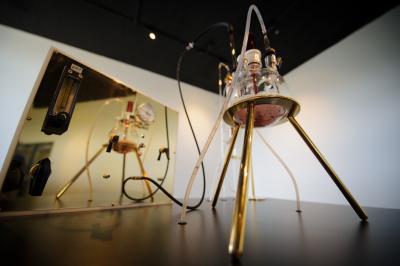Alchemy was once a pipe dream of ancient chemistry but now it is entirely possible, if you have enough energy. In the metal-tolerant bacteria Cupriavidus metallidurans it instead takes massive amounts of toxicity; the bacterium can grow on gold chloride, liquid gold, a toxic chemical compound found in nature.
The bacteria are also at least 25 times stronger than previously reported, the researchers determined in their art installation, "The Great Work of the Metal Lover," which uses a combination of biotechnology, art and alchemy to turn liquid gold into 24-karat gold. The artwork contains a portable laboratory made of 24-karat gold-plated hardware, a glass bioreactor and the bacteria, a combination that produces gold in front of an audience.
Kazem Kashefi, assistant professor of microbiology and molecular genetics at Michigan State University, and Adam Brown, associate professor of electronic art and intermedia, fed the bacteria unprecedented amounts of gold chloride, mimicking the process they believe happens in nature. In about a week, the bacteria transformed the toxins and produced a gold nugget.
Their art installation is a living system used to make art. The artwork also consists of a series of images made with a scanning electron microscope. Using ancient gold illumination techniques, Brown applied 24-karat gold leaf to regions of the prints where a bacterial gold deposit had been identified so that each print contains some of the gold produced in the bioreactor.

"The Great Work of the Metal Lover" by Adam Brown, MSU associate professor of electronic art and intermedia, is an art installation that produces gold. Credit: Photo by G.L. Kohuth, Michigan State University
"This is neo-alchemy. Every part, every detail of the project is a cross between modern microbiology and alchemy," Brown said. "Science tries to explain the phenomenological world. As an artist, I'm trying to create a phenomenon. Art has the ability to push scientific inquiry."
It would be cost prohibitive to reproduce their experiment on a larger scale, but the researchers' success in creating gold raises questions about greed, economy and environmental impact, focusing on the ethics related to science and the engineering of nature.
"The Great Work of the Metal Lover" was selected for exhibition and received an honorable mention at the world-renowned cyber art competition, Prix Ars Electronica, in Austria, where it's on display until Oct. 7. Prix Ars Electronica is one of the most important awards for creativity and pioneering spirit in the field of digital and hybrid media, Brown said.
"Art has the ability to probe and question the impact of science in the world, and 'The Great Work of the Metal Lover' speaks directly to the scientific preoccupation while trying to shape and bend biology to our will within the postbiological age," Brown said.




Comments